Columnist: "Eyes to the Sky" and "Our Place on Earth"
The Broadsheet • The Broadsheet Daily • The Berkshire Eagle • Other Selections
"Eyes to the Sky" The Broadsheet Daily online
The Broadsheet Daily, January 6-10, 2014
Venus bows out, Jupiter jumps in
by Judy Isacoff
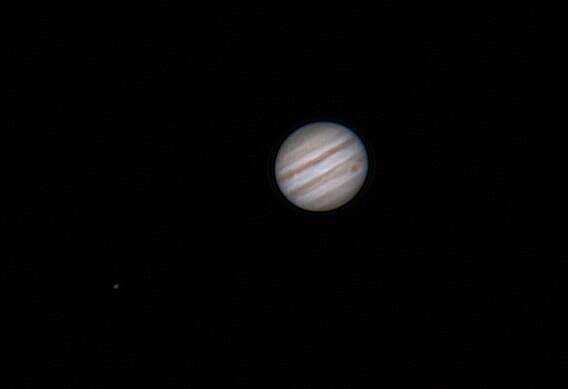
Jupiter+moon imaged recently by Paul Cotton (@paultbird66) of Lincolnshire, England.
Used with permission. Courtesy of Universe Today.
As the New Year begins, Venus, the planet that has inspired us as the Evening Star for months, is falling into the sunset radiance. It might be glimpsed today for a fond farewell. Sunset will be at 4:43, Venus follows in the path of our star at 5:32. An unobstructed view to the southwest horizon is of the essence. As the week progresses, the planet moves closer to alignment with the sun, until, on Saturday the 11th, it arrives at conjunction. It will be aligned between Earth and sun, invisible.
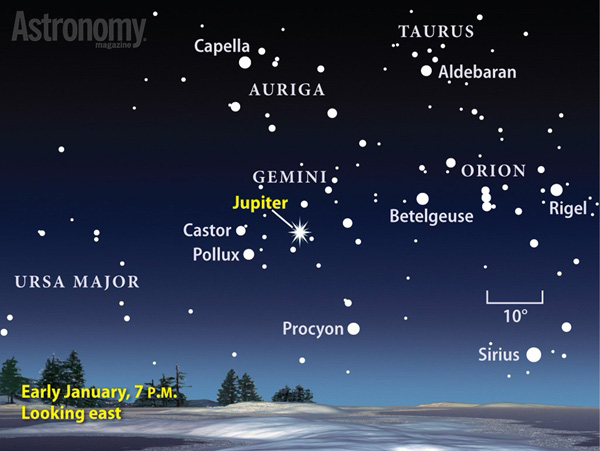
Look for Jupiter in the eastern sky during the early evening.
The giant planet resides in the constellation Gemini the Twins.
Astronomy: Roen Kelly
There's an abundance of night as January begins and three-quarters of an hour more daylight at month's end. The darkest mornings began on New Year's Eve and continue until this Friday. Sunrise is at 7:20, the latest of the year. Though early winter mornings may seem breathtakingly frigid, the celestial spectacle at dawn is more breathtakingly beautiful, warming the intellect, heart and spirit. Layers of wool and goose down from head to toe make for a luxuriously comfortable stargazer!
Adventuring out at 6:30am, eyes to the sky find the Big Dipper overhead, its handle arcing to red-orange Arcturus, the Herdsman, in the southeast. A great triangle stretches from the red giant star to tawny Mars on the lower right, with Saturn below. The star between Mars and Saturn is Spica. Turn to the west to search for brilliant Jupiter low to the horizon, looking as if it is suspended from the twin stars Castor and Pollux on two imaginary tethers.
Yesterday, the 5th, planet Jupiter arrived at opposition from the sun. As viewed from Earth, the planet, at its brightest for 2014, appeared opposite our star at sunset and sunrise. Find Jupiter rising in the northeast as the sun sets in the southwest. Continue to locate this, the brightest star-like object in the sky, in the west-northwest as day dawns.

Judy Isacoff's column always puts me in a good mood.
-- Ada Lee Halofsky
The Broadsheet Daily, December 30, 2013 - January 3, 2014
Moon New, Oh! Perigee, Perihelion, Quadrantids
by Judy Isacoff
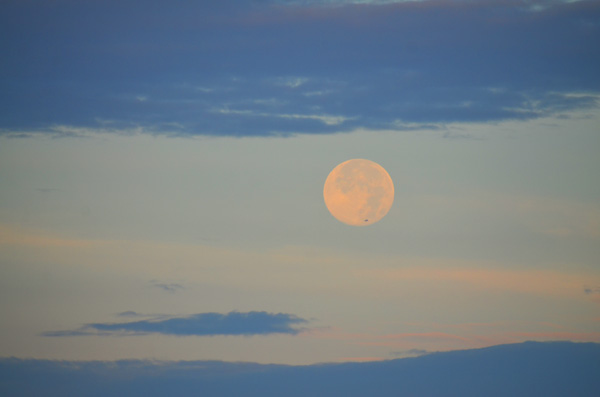
Spring tides occur at Full Moon and New Moon. Photograph of Full Moon stands in for the dark New Moon.
The New Year begins with a new moon that is at perigee on the 1st: it is closest to Earth in its monthly, elliptical orbit around our planet. On the 4th, Earth arrives at perihelion, closest to the sun in its yearly orbit around our star. Tides are greatest when the sun, moon and earth are aligned at new and full moon every month. Tides are greater still in response to the enhanced gravitational force exerted by the closer moon and sun.
Whether at the seaside or on the banks of a tidal river, there's a small but observable higher high tide and lower low tide at each new and full moon. These are called spring tides, from the Old English "springan", to rise. Perigean spring tides, when the moon is closest to Earth for the month, may be greater. The very highest high tides and lowest low tides are known as proxigean tides. These occur when the full or new moon is closest to Earth when considering a span of a year or so, not months.
When asked about this New Year's coinciding new moon, perigee and perihelion, astronomer Bob Berman offered, "I expect proxigean tides...super tides. Usually they occur one day after the new or full moon, not on the day itself. The watery bulge needs a bit of time to catch up to what's happening in space. August 10 the moon is about 17 miles closer though....." This was corroborated upon further inquiry: a proxigean spring tide is predicted for August 10.
Usher in 2014 with the Quadrantid meteor shower during the pre-dawn hours of Friday the 3rd. Although dark sky areas are best, the Quadrantids often produce fireballs and vivid, long-trailing streaks that could appear even in cities. Look between 2 and 7am either outdoors or online at NASA's site
The sun rises at 7:20 from December 31 - January 10, the latest of the year. Morning planets and stars can be seen until close to 7. Look up!
The Broadsheet Daily, November 18 - 22
Let There Be Night
by Judy Isacoff
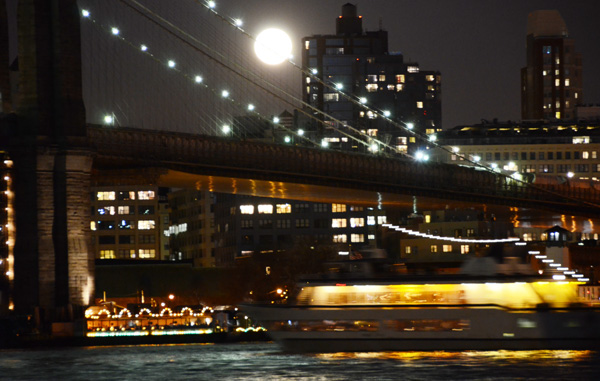
"Our fantastic civilization has fallen out of touch with many aspects of nature,
and with none more completely than with night." --Henry Beston, The Outermost House, 1933
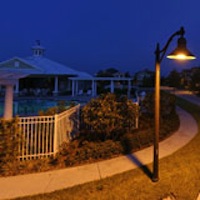
Nighttime lights can block our view of the universe and change the rhythms of life on Earth. The design of this light, covered at the top, directs the light where intended, thus reducing light trespass.
Nat'l. Geographic, Nov. 2008
Is it possible in this age of 24/7 to consider that life in the dark season offers the opportunity to allow our intellect, body and spirit to adapt to, learn from and, in the process, find renewal during winter's long nights? Determination is required to avoid lighting up the darkness to excess. A personal perspective on artificial light at night -- awareness of when we are negatively affected by over-lit environments -- prompts us to wonder how plants, animals, astronomers and the naturalist in each of us fare when deprived of darkness.
Henry Beston's observation is from eighty years ago, when electricity, and with it electric light, was not ubiquitous. Artificial illumination further promotes our separation from the night, while business interests promise everything from increased safety to must-have decorative lighting. As preparations are made for the holiday season, observe how closely commerce tries to replicate nature and lure us away from experiencing the real world.
One aspect of the problem is that artificial illumination, especially poorly designed and placed lighting, creates light trespass to unintended areas, including "sky glow", the "pea soup" sky that replaces starry nights. The International Dark Sky Association (IDA), which is celebrating its 25th anniversary this month, is dedicated to protecting the nighttime environment. To learn more and to participate, go to: www.darksky.org
The Leonid meteor shower peaked last night, Sunday, and into this morning, Monday. The intensity of the shower was obscured by sky glow from a natural source, the Full Frost Moon! Continue to be on the lookout for Leonid shooting stars during the coming nights and especially before dawn, when the moon is setting.
Relish the long nights and warm up to joining the international movement to restore and preserve dark skies.
The Broadsheet Daily, November 4 - 8
Early Evening Star Gazing and the Fall Back to Sun Time
by Judy Isacoff

Note west-southwest New Jersey skyline in this sunset photograph
from Battery Park City, October 23, 2013
For students and commuters, parents with young children and outdoor enthusiasts of all ages, now's the time to tune in to late afternoon and early evening stargazing. This evening is just the second since our clocks were synchronized with the movement of the sun: we've fallen back an hour from Eastern Daylight Time to Eastern Standard Time. Sunset and sunrise are now experienced an hour earlier by the clock, which is when they are actually happening.
Sundown is at 4:48 this evening and planet Venus will be visible soon after. There's special significance to viewing Venus tonight because the brilliant beacon arrives at its easternmost position for its current appearance in our skies. It is surprising to see our neighbor planet arrive in the southwest, which is far east of the northwestern position it held half a year ago. The wonder is that this diamond in the sky is now visible above skylines where it could not be seen until recently. Look soon after sundown, which is 4:49 this evening. Venus sets at 7:15.
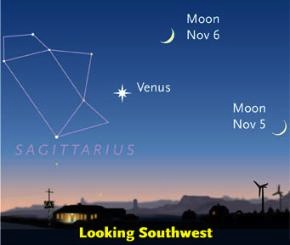
Sky & Telescope diagram
After you've spotted Venus and when twilight deepens, scan to the right to find Arcturus: its flashing red-orange light can easily be mistaken for an airplane above the west-northwestern horizon. Arcturus is the second brightest star visible from the northern hemisphere. The Guardian of the Bear sets before Venus, at about 6:30.
The stars of the Big Dipper are dimmer than Arcturus. As darkness gathers, the star pattern appears to the right, north, of the red-orange giant sun. A sure way to prove that you are looking at the sparkling star (and not an airplane) is to follow the arcing dipper handle about a handle length beyond its last star while thinking, "arc to Arcturus". The Big Dipper is a part of the constellation Ursa Major, the Great Bear. According to legend, Arcturus is watching the bear.
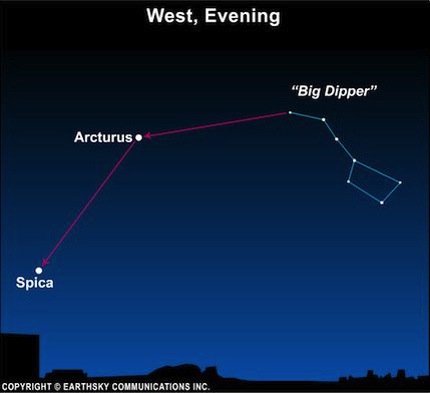
Earthsky.org
Watch Arcturus, Venus and the crescent moon this week as you greet the newfound early hour of evening twilight.
The Broadsheet Daily, September 30 - October 4, 2013
Long Nights, Morning Levity with Jupiter, Sirius
by Judy Isacoff
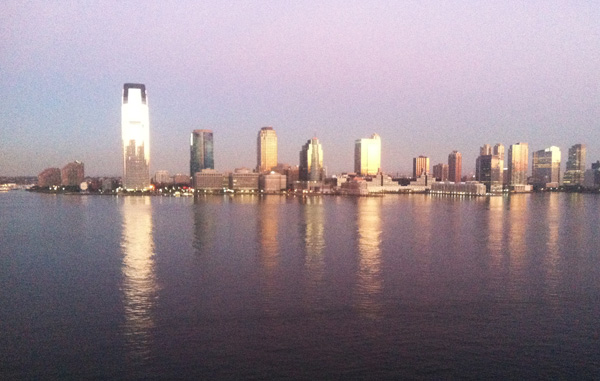
Sunrise reflected in the New Jersey skyline the morning of September 28, 2013
We are at the beginning of nearly 6 months during which night will be longer than day. The length of day will continue to decrease a few minutes almost everyday in October. Add to this the fact that clocks are set for Eastern Daylight Time - which puts sunrise an hour later than actual - and we'll find that the dark of night is increasingly present in the early morning. And so we rise to commune with the stars at usual, or nearly usual, wake-up time.
The crispness and clarity of the early autumn air and atmosphere at daybreak is inviting, if not alluring, whether deliciously balmy or presciently brisk. Even as a pale blue-green band lights the eastern horizon at 6am these days, celebrated stars of winter nights paint the sky to the south. In addition, planet Jupiter, a diamond high in the southeast, is bright until about 6:30. A waning (decreasing in size) crescent moon enhances the cosmic panoply all week, through Thursday. New moon occurs at 8:35pm on Friday.
Returning to the darkness at 6am, when Jupiter's beacon shines near zenith, see next brightest, radiant Sirius the Dog Star, below and to the planet's right. Dimmer, tawny Mars is to the left, east of the giant planet. The wonderful figure of Orion the Hunter stretches above Sirius: reddish Betelgeuse is above 3 stars in a row, the hunter's belt, with blue-white Rigel below it. Bright, red-orange Aldebaran of Taurus the Bull stands out to Orion's right. At 6:20, Jupiter, Sirius and Rigel can still be seen with ease, creating a triangle of the brightest lights. Look with a soft gaze to find Orion's studded belt that is being washed over by dawn's light.
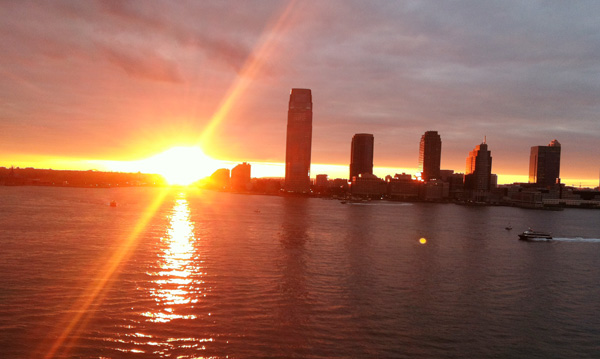
Sunset over New Jersey the evening of September 28, 2013

